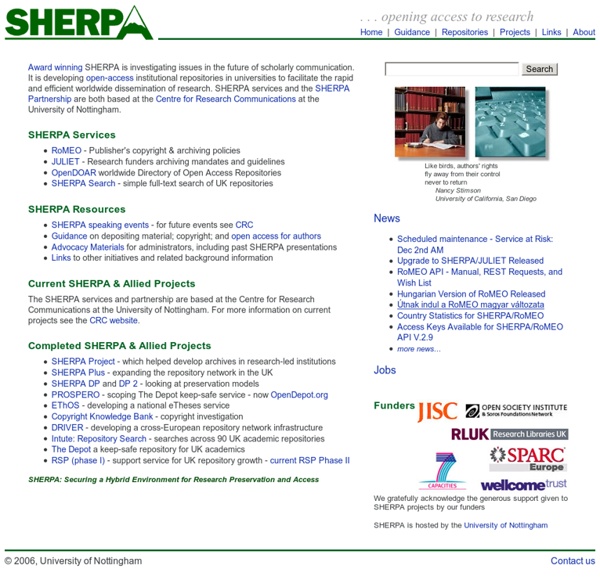



Registry of Open Access Repositories Impact factor Calculation[edit] In any given year, the impact factor of a journal is the average number of citations received per paper published in that journal during the two preceding years.[1] For example, if a journal has an impact factor of 3 in 2008, then its papers published in 2006 and 2007 received 3 citations each on average in 2008. The 2008 impact factor of a journal would be calculated as follows: A = the number of times that articles published in that journal in 2006 and 2007, were cited by articles in indexed journals during 2008. B = the total number of "citable items" published by that journal in 2006 and 2007. 2008 impact factor = A/B. (Note that 2008 impact factors are actually published in 2009; they cannot be calculated until all of the 2008 publications have been processed by the indexing agency.) Use[edit] The impact factor is used to compare different journals within a certain field. Criticisms[edit] Numerous criticisms have been made of the use of an impact factor. Responses[edit]
SciPlore NDLTD: Digital Theses Tim Albert 2009 - (Wu et al) Rankings of Academic Journals in Accounting, Finance, and Information System Perception from the College Chairpersons by Ji Wu, Qian Hao, Michelle Y.M. Yao Ji Wu Institute for Financial and Accounting Studies Qian Hao Wilkes University Michelle Y.M. Yao Tulane UniversityMarch 23, 2009 International Journal of Accounting and Information Management, Vol. 17, No. 1, pp. 66-105, 2009 Abstract: Purpose – The purpose of this paper is report the importance of research publications for the tenure promotion and for faculty in accounting, finance, and information system (IS) areas, developing valid criteria for the assessment of quality in related journals is necessary. Design/methodology/approach – Existing rankings are usually based on a survey among faculty members, while ignoring the chairs’ critical role in tenure evaluation. Findings – It is found that the rankings in accounting and finance areas are consistent with the prior research, but the rankings in the IS have changed significantly. Number of Pages in PDF File: 40 Keywords: Publications, Research, Accounting, Finance, Information Systems Accepted Paper Series Suggested Citation
Oxford Open Oxford Open OUP Supports Open Access Oxford University Press (OUP) is mission-driven to facilitate the widest possible dissemination of high-quality research. We embrace both green and gold open access (OA) publishing to support this mission. A Proven Track Record of Success OUP has been publishing OA content since 2004. We have also successfully launched or taken over high-quality OA titles, including: Genome Biology and Evolution, Journal of Legal Analysis, Progress of Theoretical and Experimental Physics, and Database. OUP facilitates green OA either by allowing authors to deposit versions of their manuscripts in institutional or subject repositories after a specified time period, or depositing the version of record on their behalf. Supporting the Evolution of Open Access Publishing Sustainable, high-quality OA publishing requires either funding to be available to pay for Article Processing Charges, sponsorship, or suitable embargo periods. OUP operates two different open access models:
Primo Levi Biography[edit] Early life[edit] Levi was born in 1919 in Turin, Italy, at Corso Re Umberto 75, into a liberal Jewish family. His father Cesare worked for the manufacturing firm Ganz and spent much of his time working abroad in Hungary, where Ganz was based. Cesare was an avid reader and autodidact. In 1921 Anna Maria, Levi's sister was born; he was to remain close to her all his life. In September 1930 Levi entered the Massimo d'Azeglio Royal Gymnasium a year ahead of normal entrance requirements.[5] In class he was the youngest, the shortest and the cleverest, as well as being the only Jew. In July 1934 at the age of 14, he sat the exams for the Massimo d'Azeglio liceo classico, a Lyceum (sixth form) specialising in the classics, and was admitted that autumn. At the end of the summer he finally passed his Italian exam, and in October he enrolled at the University of Turin, to study chemistry. Chemistry[edit] - Account held at Yad Vashem. Auschwitz[edit] Writing career[edit] 1946–1960[edit]
2005 - (Davison et al) On Peer Review Standards For the Information Systems Literature Abstract The quality of research published in journals is not only dependent on the work performed by authors, but also on the service undertaken by peer reviewers. In this paper, we take a two-pronged qualitative approach to establish an integrated set of criteria for reviewers, for the reviews they produce, and for the papers they review in the IS domain. These criteria are intended to be of value to three sets of stakeholders: authors, reviewers and editors. Authors should find them useful as they write, knowing in advance how reviewers are evaluating their work; reviewers should find them useful to improve the quality of the reviews of manuscripts; editors should use them to ensure that manuscripts are well written and that reviewers performed their tasks effectively. We discuss the implications of these criteria for the review process and identify areas for future research. Recommended Citation
Budapest Open Access Initiative | Budapest Open Access Initiative John Carey (critic) John Carey (born 5 April 1934) is a British literary critic, and emeritus Merton Professor of English Literature at the University of Oxford . He was born in Barnes , London , and educated at Richmond and East Sheen Boys’ Grammar School, winning an Open Scholarship to St John's College , Oxford . He served in the East Surrey Regiment , 1952-4, and was commissioned. After posts in a number of Oxford colleges, he became Merton Professor in 1975, retiring in 2001. He is known, amongst other things, for his anti-elitist tone and iconoclastic views on high culture , as expressed for example in his book What Good Are the Arts? He has twice chaired the Booker Prize committee, in 1982 and 2004, and chaired the judging panel for the first Man Booker International Prize in 2005. Works [ edit ] External links [ edit ]